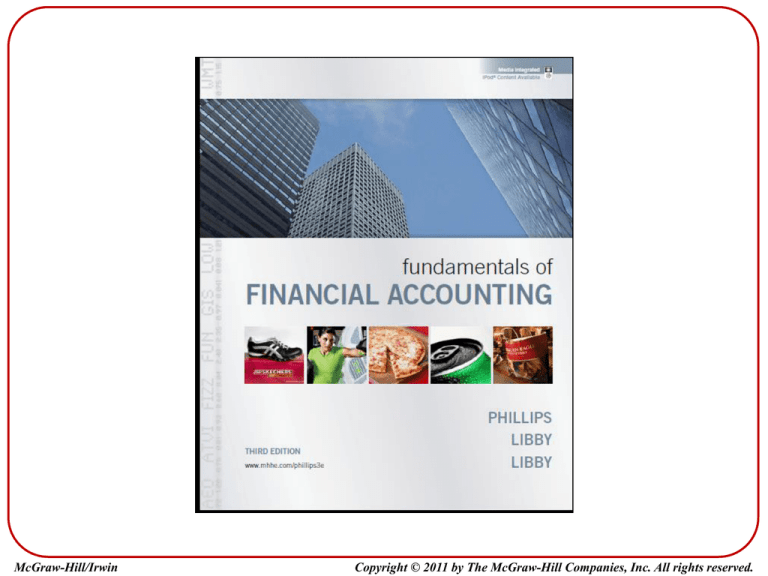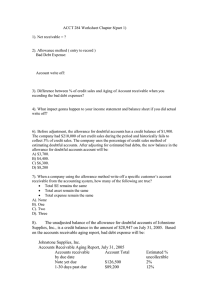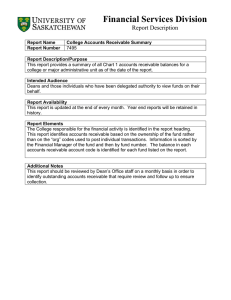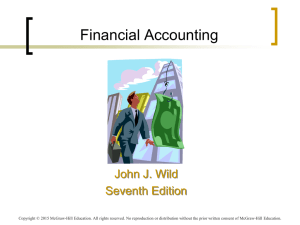
McGraw-Hill/Irwin
Copyright © 2011 by The McGraw-Hill Companies, Inc. All rights reserved.
Chapter 8
Reporting and Interpreting
Receivables, Bad Debt Expense, and
Interest Revenue
PowerPoint Authors:
Susan Coomer Galbreath, Ph.D., CPA
Charles W. Caldwell, D.B.A., CMA
Jon A. Booker, Ph.D., CPA, CIA
Fred Phillips, Ph.D., CA
Accounts Receivable and Bad Debts
Jan. 1
Record sales on account
Bad debt known
dr Accounts Receivable
cr Sales Revenue
Balance Sheet
8-3
Income Statement
Cash
Sales Revenue
Accounts Receivable
Cost of Goods Sold
Inventory
Gross Profit
…
…
Accounts Receivable and Bad Debts
Jan. 1
Jan. 31
Record sales on account
dr Accounts Receivable
cr Sales Revenue
Record estimate of bad debts
dr Bad Debt Expense (+E, -SE)
cr Allowance for Doubtful Accounts (+xA, -A)
Balance
Sheet
Balance
Sheet
8-4
Bad debt known
Income Statement
Cash
Cash
Accounts
Receivable
Accounts Receivable
Less: Allowance for Doubtful Accounts
Inventory
Accounts Receivable, Net
Sales Revenue
…
Inventory
… Debt Expense
Bad
…
…
Cost of Goods Sold
Gross Profit
Accounts Receivable and Bad Debts
Jan. 1
Jan. 31
Record sales on account
dr Accounts Receivable
cr Sales Revenue
Balance
Sheet
Balance
Sheet
Cash
Cash
Accounts
Receivable
Accounts Receivable
Less: Allowance for Doubtful Accounts
Inventory
Accounts Receivable, Net
…
Inventory
…
8-5
Record estimate of bad debts
Bad debt known
dr Bad Debt Expense (+E, -SE)
cr Allowance for Doubtful Accounts (+xA, -A)
dr Allowance for Doubtful Accounts (-xA)
cr Accounts Receivable(-A)
Allowance Method
The allowance method follows a two-step
process, described below:
1. Make an end-of-period adjustment to
record the estimated bad debts in the
period credit sales occur.
2. Remove (“write off”) specific customer
balances when they are known to be
uncollectible.
8-6
2. Remove (Write-off) Specific Customer Balances
dr
Bad Debts Expense (+E) (-SE)
cr Allowance for Doubtful Accounts (+xA) (-A)
dr
900
900
Allowance for Doubtful Accounts (-xA) (+A)
cr Accounts Receivable (-A)
800
800
dr +
Accounts Receivable (A)
cr Beg. Bal. 200,800
800 Write-off
End. Bal. 200,000
dr - Allow. For Doubtful Accts (xA) cr +
14,900 Beg. Bal.
Write-off
800
900 Est.
15,000 End. Bal.
8-7
dr +
Bad Debt Expense (E, SE))
Beg. Bal.
Est.
900
End. Bal.
900
cr -
Methods for Estimating Bad Debts
There are two acceptable methods of estimating
the bad debts in a given period.
1. Percentage of Credit Sales Method.
2. Aging of Accounts Receivable.
Simpler to apply.
More accurate
8-8
Percentage of Credit Sales Method
The percentage of credit sales method
estimates bad debt expense by
multiplying the historical percentage of
bad debt losses by the current period’s
credit sales.
Net credit sales for the period
× Historical bad debt loss rate
= Bad debt expense of the period.
8-9
Aging of Accounts Receivable
While the percentage of credit sales method focuses on
estimating Bad Debt Expense (income statement approach) for
the period, the aging of accounts receivable method focuses on
estimating the ending balance in the Allowance for Doubtful
Accounts (balance sheet approach).
The aging method gets its name because it is based on the
“age” of each amount in Accounts Receivable at the end of the
period. The older and more overdue an account receivable
becomes, the less likely it is to be collectible.
8-10
Other Issues
Let’s assume that Skechers collects the $800 from Fast Footwear
that was previously written off. This recovery would be recorded
with the following journal entries:
(1) Reverse the write-off.
(2) Record the collection.
8-11
Calculating Interest
Interest (I) = Principal (P) × Interest Rate (R) × Time (T)
The amount of the
note receivable
The annual interest rate
charged on the note
The time period for
interest calculation
See if you can calculate the interest below using your calculator.
Information Given
Terms of Note
Interest Period
$10,000, 6%, due in two years
Jan 1 - Mar 31
$10,000, 6%, due in one year
Mar 1 - Mar 31
$10,000, 6%, due in 100 days
Mar 1 - Mar 31
8-12
Interest Calculation
Principal
Rate Time Interest
$ 10,000 × 6% × 3/12 = $ 150
10,000 × 6% × 1/12 =
50
10,000 × 6% × 1/12 =
50
Recording Notes Receivable and Interest Revenue
The four key events that occur with any note receivable are:
Date of Note Receivable
Annual Interest Rate
Amount of the Note
Maturity Date of Note
Year End of Company
8-13
November 1, 2009
6%
$100,000
October 31, 2010
December 31, 2009
Receivables Turnover Analysis
The receivables turnover ratio indicates how many
times, on average, this process of selling and collecting
is repeated during the period. The higher the ratio, the
faster the collection of receivables.
Rather than evaluate the number of times accounts
receivable turn over, some people find it easier to think
in terms of the number of days to collect receivablese
(called days to collect).
8-14
Direct Write-Off Method
On October 13, 2009, we sold merchandise on account to
Fast Footwear for $1,000. On February 1, 2010, Fast
Footwear declared bankruptcy and had made no payments
toward the $1,000 balance in its account receivable.
February 1, 2009
2
Record
dr
8-15
Bad Debt Expense (+E, -SE)
cr Accounts Receivable ( -A)
1,000
1,000
End of Chapter 8



